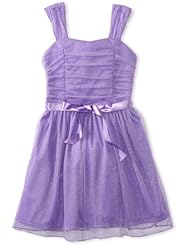Purple Dresses For Girls Definition
Source (Google.com.pk)
One mother talks about her son's desire to dress in 'girl' clothes.
During my son's preschool years, he preferred to wear dresses and tights over pants; pink and purple clothing rather than blue or gray; and his red bikini instead of boys' swim trunks. He liked wearing girls' clothing so much that he almost never put on his jeans or "boy" clothes unless we were going to a family event or place that would not have been accepting of his choices.
While his choice of clothes caused some concern for the grandparents, the one place he felt truly safe and free was his nursery school. My son attended UCNS, a parent cooperative, in Ithaca, N.Y., for two years. He would often arrive in his purple dress with black flowers or, if he wasn't wearing a dress when he arrived, he would head straight for the dress up corner where he would put on a red dress with long sleeves and a zipper in the back. Then he would look for a pair of play high heels, either the ones with purple leopard print or the ones with fake fur.
His teachers, Jayne Kemp and Jaime Jacobs-Rossfeld, neither encouraged nor discouraged my son's choice of clothing. Kemp, with more than 30 years of early childhood education experience, believes that young children don't have notions of gender like adults do. "Children don't come with pre-conceived notions of gender," she said in a recent interview. "It's all in how the adults handle it."
Kemp's philosophy on gender identity at the preschool level follows her general philosophy on children: They learn about themselves and their world through play, and their needs must be met and not denied by the adults in their lives. When their needs are met, Kemp believes, they move on to the next stage of development. When their needs aren't met, they don't go away, but become suppressed by the child and will find other ways of being expressed.
As for my son, Kemp believes that he has a real need to wear the clothes he does. For one, he likes dresses because he thinks they are more comfortable, and for another, he likes the colors pink, purple and light yellow, and unfortunately, clothing manufacturers only make girls' clothing in those colors.
At UCNS however, the dress-up area was never labeled as "girl" or "boy." Indeed, no play area was labeled with any kind of gender definition. This all helped my son process the other comments he was picking up from friends and family outside of school.
Luckily, Kemp says that no child ever commented on my son's choice of clothing, but if someone had, she would have handled it by asking the children a few simple questions in order to help them process their ideas.
For example, if a child had teased my son by saying something like, "Boys don't wear dresses," Kemp would have asked my son why he likes the red dress. Then she would have asked the other child why my son shouldn't wear the dress. In order to help the children work through the situation, she would say, "Adrian likes the red dress, and at this school you can wear whatever you want. You don't like the red dress, so you don't have to wear it."
Kemp says that using the child's name is one of the best things a teacher can do. Kids often wonder why someone eats or doesn't eat a particular food, or wears or doesn't wear a particular kind of clothing. Kemp responds matter-of-factly to these types of inquiries, "Jill's eating those grapes because that's what Jill likes to eat."
Questions about gender are handled equally as matter-of-factly. Kemp says, "It's really about valuing differences, and it needs to start here, in the early childhood classroom."
The effect this had on my son has been comfort with his own body, happiness that he is loved for who he is and not what he wears, and increased self-esteem from not being put down or demoralized for doing something that comes naturally to him.
He is 6 now and in first grade, and he still likes to dress up in girls' clothing. I've learned a lot from Jayne Kemp, and simply tell people who ask about his clothing, "That's just what he likes to wear."
My son's experience at preschool equipped him with the confidence to do what feels right for him and the self-awareness to think through the myriad issues that have arisen from this.
He's had family members, friends and kids at elementary school point out that he's wearing a "girl's shirt" or has a "girl's lunchbox," but having already processed these types of assumptions and having come to the conclusion on his own that clothes and lunchboxes don't have a gender, he's able to say to these people, "Well, I'm a boy, and because this shirt is on me, it's a boy's shirt."
Purple Dresses For Girls Image Photo Picture2013

Purple Dresses For Girls Image Photo Picture2013

Purple Dresses For Girls Image Photo Picture2013

Purple Dresses For Girls Image Photo Picture2013

Purple Dresses For Girls Image Photo Picture2013

Purple Dresses For Girls Image Photo Picture2013

Purple Dresses For Girls Image Photo Picture2013

Purple Dresses For Girls Image Photo Picture2013

Purple Dresses For Girls Image Photo Picture2013

Purple Dresses For Girls Image Photo Picture2013

Purple Dresses For Girls Image Photo Picture2013
No comments:
Post a Comment